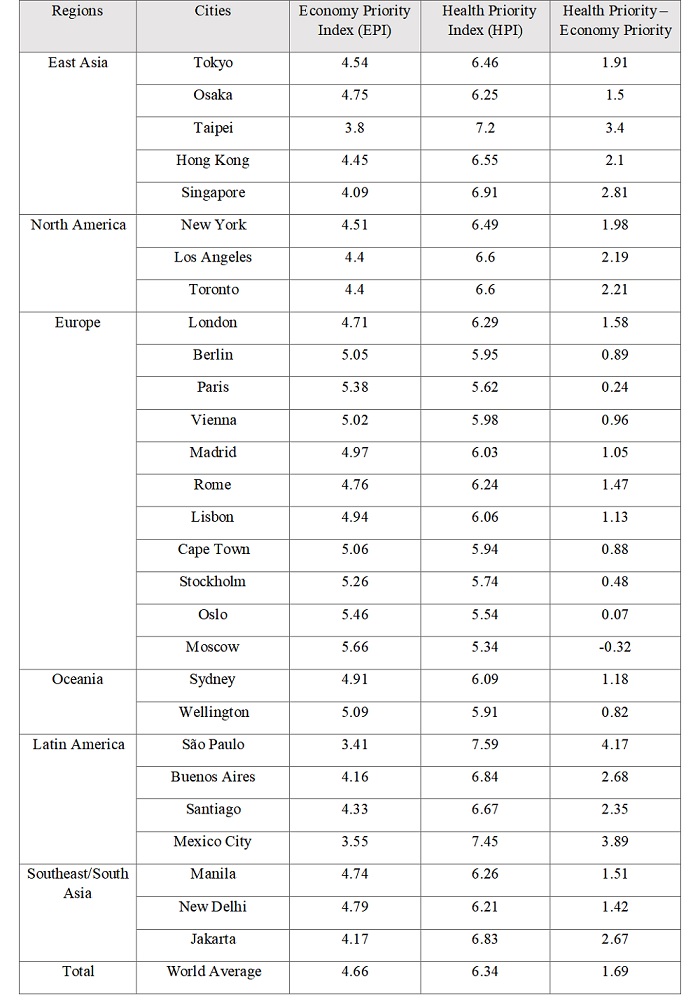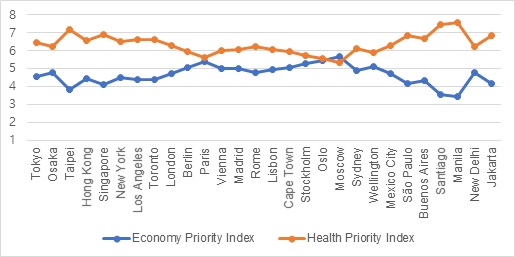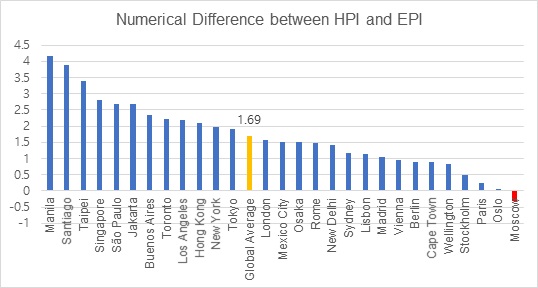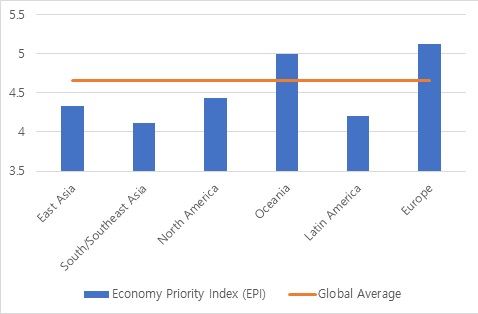Preference Between Public Health and Economic Recovery
by Global Citizens 1.
Background Continuing the last chapter’s debate on
disaster weathering priority and civil liberties priority index, this chapter
will deal with global citizens’ preference between public health and economic
recovery during the pandemic era. Balancing public health and economic recovery
is also a one of the most vital issues during an abnormal situation. For rejuvenating
economic activities, the UK government has driven the “Eat Out to Help Out
Scheme” to encourage citizens to consume at restaurants and cafes. Similarly,
the South Korean government drove the “Invigorating to Eat Out Campaign” as
well, however, as the COVID-19 situation was rapidly getting worse in Seoul and
Gyeonggi area, the government has stopped the campaign and elevated the social
distancing to the second phase on August, 16th. During the COVID-19
situation, governments should be alert of the current situation and quickly handle
the issue, whether it is a disease or economic crisis. This section focuses on figuring
out on which side are global citizens inclining to, and the data analysis would
help understand people’s value propensity and provide meaningful information to
governments and researchers. 2.
Research
Topic As the COVID-19 crisis rises severe, it
has been highly recommended by governments that people should stay at home and
avoid social gatherings, and therefore, national consumption has been declining
sharply. Moreover, there were a lot of predictions by economists that the
international society would face economic crisis worse than the one that happened
in 2008. However, a government could not make policies to spur economic
vitalization at ease, since the more social gatherings, the more virus cases
might cause. In this complicated circumstance, we are going to analyze what
value global citizens emphasize more, and how the preference differs by region. 3.
Questionnaire
Used Survey Question II-2-2: “In the current
situation, what do you think is a more urgent task set before your country
between social distancing for public health and returning to normal life for economic
recovery?”
The answers consist of a 10-point scale,
with higher scores indicating an individual who emphasizes more on economic
recovery and lower scores demonstrating a person who underlines public health.
4.
Major
Outcomes Table
1: Distribution Table of Health Priority and Economy Priority Scores
|
|
Health
Priority ←→ Economy Priority
|
|
|
|
1
|
2
|
3
|
4
|
5
|
6
|
7
|
8
|
9
|
10
|
Total
|
|
Health Priority
VS
Economy Priority
|
19.2
|
7.8
|
10.5
|
10.7
|
14.1
|
10.6
|
10.1
|
7.5
|
3.7
|
5.9
|
100
|
|
62.3
|
37.7
|
100
|
The table
indicates the percentage of how many global citizens have chosen the
corresponding score. For instance, the number “19.2” demonstrates that 19.2% of
global citizens have chosen the “1” answer. To illustrate, 19.2% of individuals
around the globe highly put an emphasis on implementing social distancing to
protect public health. Likewise, the number “5.9” in the table means that 5.9%
of people urgently put stress on the national economy. Also, the table shows
that 62.3% of global citizens highlight overcoming a disaster by social
distancing rather than economic recovery, whereas 37.7% of people are in the
opposite position. Table 2: Economy Priority Index (EPI)
and Health Priority Index (EPI)
by Citizens of 28 Global Cities  For comparing which side is more predominant in
every single city, reverse scaling is used in this study. The average scores of
each city indicate the Health Priority Index (HPI), and 11 minus HPI demonstrates
Economy Priority Index (EPI). The numerical differences between the two were
calculated in order to show the gap between health priority and economy
priority of 28 global citizens.
Figure 1: Line Graph of Economy
Priority Index (EPI) and Health Priority Index (HPI)  This figure is a visualized version of Table 2, and
the most outstanding finding of
Figure 1 is that all HPIs are higher than EPIs except Moscow. It illustrates
that hurdling a disaster is put an emphasis during the COVID-19 by global
citizens. Nonetheless, citizens in Moscow prefer economic development to social
distancing during the crisis.
Figure 2: Bar Graph of Numerical Difference
between Health Priority Index (HPI) and Economy Priority Index (EPI)

The differences
between HPIs and EPIs are drawn as a bar graph, shown in Figure 2. The yellow
bar indicates the global average difference score (1.69). The bigger the
difference scores, the more citizens are weighing on social distancing to overcome
a disaster. In this sense, Moscow citizens are accenting economic recovery the
most, followed by Oslo, Paris, Stockholm, and Wellington. On the other hand, people
in Manila have the least interest in economic activities during the crisis and
are willing to focus more on overcoming a disaster by actively participating in
the social distancing behavior compared to other countries in the world. The
top five highest difference scores are represented by Manila, Santiago, Taipei,
and Singapore, most of which are Asian countries. Moreover, all difference
scores except Moscow are positive numbers, which implies that 27 cities around
the globe are making much of getting through the disaster in the COVID-19 era.
Table 3: Average Economy Priority Index
(EPI) by Region
Regions
|
Average Economy Priority Index (1 – 10)
|
East Asia
|
4.33
|
Southeast/South Asia
|
4.12
|
North America
|
4.44
|
Oceania
|
5.00
|
Latin America
|
4.20
|
Europe
|
5.12
|
The scores in the
table are the average Economy Priority Index (EPI) of the global citizens by
region. To be specific, the lowest score of 4.12 was rated by Southeast and
South Asian citizens on average. It demonstrates that people in this region tend
to put more stress on social distancing than the economic recovery compared to
other regions in the world. On the contrary, the highest score of 5.12 was
rated by European citizens, which illustrates that people here highlight more
on a sustainable economy than social distancing. All in all, Oceania (5.00) and
Europe (5.12) relatively concern more about the economy, whereas other regions
such as Asia, North America, and Latin America worry more about the health
issue.
Figure 3: Bar Graph of Average Economy
Priority Index by Region

Figure 3 is the
visualized graph of Table 3, and the orange line is the world average economy
priority index. The graph identifies that European and Oceanian citizens are
inclined to prioritize the national economy when compared to other regions in
the world. On the other hand, Southeast/South Asian people are showing the least
interest in economic policies.
Figure 4: Scatter Plot - Individualistic Tendency
of 28 Global Cities

The corresponding
index of Civil Liberties Priority Index (CLPI) and Economy Priority Index (EPI)
are Disaster Weathering Priority Index (DWPI) and Health Priority Index (HPI). The
former two indexes are individual-level values, and the latter two indexes are
communal-level values. Hence, for identifying the relationship between the two
individual-level values, the study selected CLPI and EPI to draw a scatter
plot. The horizontal line indicates CLPI, and the vertical line represents EPI.
If the dots are revolving around the y = x line, it illustrates that the two
indexes have a positive relationship. The Figure shows us that the higher CLPI
is, the higher the EPI shows. For instance, Oslo citizens weight both on civil
liberties and economic activities; yet, people in Manila make little of either
liberties or economy.
Besides, dots
under the y = x line demonstrate that the citizens of the city value more civil
liberties than economic recovery, and vice versa. To illustrate, Europeans
accent both on civil liberties and economic recovery, but they are interested
more in going back to normal life by economic restoration. Similarly, the
figure demonstrates that East Asian people are having little affection either on
liberties or the economy, but they also have more interests in the economy
since most dots are above the y = x line.
5.
Summaries
and Further Tasks
a.
Generally
speaking, global citizens regard social distancing as important than economic
recovery.
b.
Global
citizens prioritize social distancing then economic restoration during the
COVID-19 era since the numeric difference scores of Health Priority Index (HPI)
and Economy Priority Index (EPI) are positive. Yet, Moscow is the only city
shows the negative difference between the two, implying that the citizens in
Moscow put more emphasis on economic rehabilitation than social distancing.
c.
Oceanian
and European average EPIs are higher than the global average, indicating these
two regions are sensitive about economies, whereas Southeast/South Asian
average EPI scored the lowest.
d.
The
study is limited to descriptive research, and therefore, more detailed
explanative investigation is required to further understand the global citizens’
consciousness presented above. For instance, why people in Oceania and Europe are
showing much interest in economic activities? Why people in Moscow are highly
interested in economic recovery? And why citizens are emphasizing more on the
economy than civil liberties? |